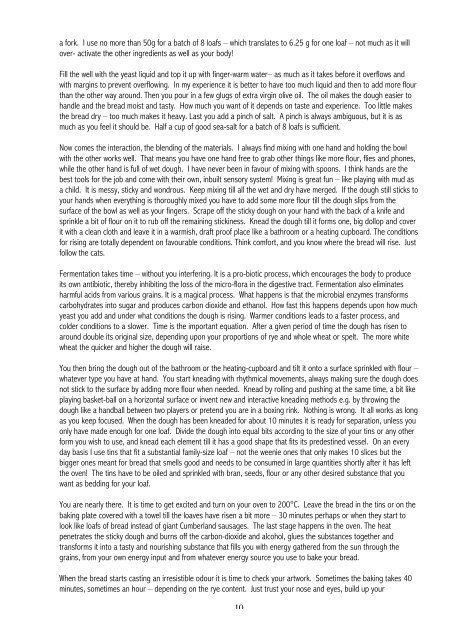THE COMPANION FESTIVAL OF BREAD - Eva Bakkeslett
THE COMPANION FESTIVAL OF BREAD - Eva Bakkeslett
THE COMPANION FESTIVAL OF BREAD - Eva Bakkeslett
You also want an ePaper? Increase the reach of your titles
YUMPU automatically turns print PDFs into web optimized ePapers that Google loves.
a fork. I use no more than 50g for a batch of 8 loafs – which translates to 6.25 g for one loaf – not much as it will<br />
over- activate the other ingredients as well as your body!<br />
Fill the well with the yeast liquid and top it up with finger-warm water– as much as it takes before it overflows and<br />
with margins to prevent overflowing. In my experience it is better to have too much liquid and then to add more flour<br />
than the other way around. Then you pour in a few glugs of extra virgin olive oil. The oil makes the dough easier to<br />
handle and the bread moist and tasty. How much you want of it depends on taste and experience. Too little makes<br />
the bread dry – too much makes it heavy. Last you add a pinch of salt. A pinch is always ambiguous, but it is as<br />
much as you feel it should be. Half a cup of good sea-salt for a batch of 8 loafs is sufficient.<br />
Now comes the interaction, the blending of the materials. I always find mixing with one hand and holding the bowl<br />
with the other works well. That means you have one hand free to grab other things like more flour, flies and phones,<br />
while the other hand is full of wet dough. I have never been in favour of mixing with spoons. I think hands are the<br />
best tools for the job and come with their own, inbuilt sensory system! Mixing is great fun – like playing with mud as<br />
a child. It is messy, sticky and wondrous. Keep mixing till all the wet and dry have merged. If the dough still sticks to<br />
your hands when everything is thoroughly mixed you have to add some more flour till the dough slips from the<br />
surface of the bowl as well as your fingers. Scrape off the sticky dough on your hand with the back of a knife and<br />
sprinkle a bit of flour on it to rub off the remaining stickiness. Knead the dough till it forms one, big dollop and cover<br />
it with a clean cloth and leave it in a warmish, draft proof place like a bathroom or a heating cupboard. The conditions<br />
for rising are totally dependent on favourable conditions. Think comfort, and you know where the bread will rise. Just<br />
follow the cats.<br />
Fermentation takes time – without you interfering. It is a pro-biotic process, which encourages the body to produce<br />
its own antibiotic, thereby inhibiting the loss of the micro-flora in the digestive tract. Fermentation also eliminates<br />
harmful acids from various grains. It is a magical process. What happens is that the microbial enzymes transforms<br />
carbohydrates into sugar and produces carbon dioxide and ethanol. How fast this happens depends upon how much<br />
yeast you add and under what conditions the dough is rising. Warmer conditions leads to a faster process, and<br />
colder conditions to a slower. Time is the important equation. After a given period of time the dough has risen to<br />
around double its original size, depending upon your proportions of rye and whole wheat or spelt. The more white<br />
wheat the quicker and higher the dough will raise.<br />
You then bring the dough out of the bathroom or the heating-cupboard and tilt it onto a surface sprinkled with flour –<br />
whatever type you have at hand. You start kneading with rhythmical movements, always making sure the dough does<br />
not stick to the surface by adding more flour when needed. Knead by rolling and pushing at the same time, a bit like<br />
playing basket-ball on a horizontal surface or invent new and interactive kneading methods e.g. by throwing the<br />
dough like a handball between two players or pretend you are in a boxing rink. Nothing is wrong. It all works as long<br />
as you keep focused. When the dough has been kneaded for about 10 minutes it is ready for separation, unless you<br />
only have made enough for one loaf. Divide the dough into equal bits according to the size of your tins or any other<br />
form you wish to use, and knead each element till it has a good shape that fits its predestined vessel. On an every<br />
day basis I use tins that fit a substantial family-size loaf – not the weenie ones that only makes 10 slices but the<br />
bigger ones meant for bread that smells good and needs to be consumed in large quantities shortly after it has left<br />
the oven! The tins have to be oiled and sprinkled with bran, seeds, flour or any other desired substance that you<br />
want as bedding for your loaf.<br />
You are nearly there. It is time to get excited and turn on your oven to 200°C. Leave the bread in the tins or on the<br />
baking plate covered with a towel till the loaves have risen a bit more – 30 minutes perhaps or when they start to<br />
look like loafs of bread instead of giant Cumberland sausages. The last stage happens in the oven. The heat<br />
penetrates the sticky dough and burns off the carbon-dioxide and alcohol, glues the substances together and<br />
transforms it into a tasty and nourishing substance that fills you with energy gathered from the sun through the<br />
grains, from your own energy input and from whatever energy source you use to bake your bread.<br />
When the bread starts casting an irresistible odour it is time to check your artwork. Sometimes the baking takes 40<br />
minutes, sometimes an hour – depending on the rye content. Just trust your nose and eyes, build up your<br />
10




